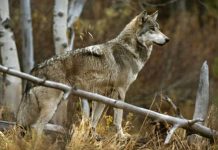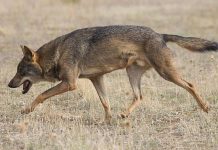The gray wolf (Canis lupus) is the carnivorous mammal. Like many other terrestrial carnivores, gray wolf also eats herbivorous mammals. Most of its diet consists of medium to large-sized mammals much less ungulates weighing as much as 530 – 1,430 pounds. Gray wolves are mostly most active at night. They will prey on deer, bighorn sheep, elk, marmots, weasels, badgers, voles, hamsters, foxes, mice, hares, and ground squirrels. In the western Canada, the wolf supplements its diet with Pacific salmon and fish.
What Do Gray Wolves Eat in the Wild?
Gray wolves can also take down a 1,000-pound-heavy moose. They consume many microtine rodents, bird eggs, lagomorphs, waterfowls, snakes, toads, lizards, insects, and carrion. But these preys are preferred only when the ungulates are not available. It indeed suggests that ungulates are the primary prey of gray wolves. Although less so often gray wolf’s diet also consists of primates, Caspian seal, salmon, grey langurs, and baboons. Gray wolves fancy their chances in hunting young or weak animals.
The Eurasian population is thought to rely on domestic livestock as well as roe deer, wild boar, red deer, and moose. The Russian wolves will feed on wild goats, reindeer, chamois, musk deer, mouflon, argali, fallow deer, ibex, saiga, and wisent.
Over the past many centuries the gray wolves have eventually evolved to occupy their ecological niche. They have turned out to be the apex predators. Gray wolves inhabiting North America will prey on Dall’s sheep, muskox, white-tailed deer, mule deer, American bison, caribou, and bighorn sheep.
Wolves also occasionally eat fruits and veggies such as lily of the valley, cowberry, mountain ash, blueberries, pears, apples, nightshade, and bilberries. During summer gray wolves feed on melons.
References
Heptner, V.G. and Naumov, N.P. (1998). Mammals of the Soviet Union Vol.II Part 1a, SIRENIA AND CARNIVORA (Sea cows; Wolves and Bears), Science Publishers, Inc. USA., pp. 164-270.
Encyclopædia Britannica, The Editors of Encyclopædia Britannica, inc.


